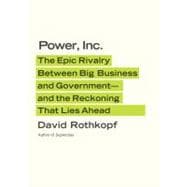
Note: Supplemental materials are not guaranteed with Rental or Used book purchases.
Purchase Benefits
David Rothkopf is the internationally acclaimed author of Superclass: The Global Power Elite and the World They Are Making and Running the World: The Inside Story of the National Security Council and the Architects of American Power. He is the president and chief executive of Garten Rothkopf, an international advisory firm, and a visiting scholar at the Carnegie Endowment for International Peace and CEO and Editor-at-Large of the FP Group, publishers of Foreign Policy Magazine.
“The frontier between governments and markets is constantly shifting. Focusing on this contested border, David Rothkopf vividly describes the parallel rise of the modern nation-state and the modern corporation. In an age of globalization, Rothkopf argues that this frontier urgently needs to be redrawn. Readers, whether they agree or not, will be compelled to rethink today’s economic travails and reassess expectations for tomorrow.”— Daniel Yergin, author of The Quest: Energy, Security and the Remaking of the Modern World and Commanding Heights: the Battle for the World Economy
“It would be hard to find a timelier book than Power, Inc. Where we draw the line between public and private power will shape the 21st century just as the divide between communism and capitalism shaped the 20th. The full dimensions of that struggle are just beginning to emerge, but David Rothkopf, as usual, is ahead of the curve with a provocative, insightful book that is easy to read and hard to put down.” —Anne-Marie Slaughter, Bert G. Kerstetter University Professor of Politics and International Affairs. Princeton University
The New copy of this book will include any supplemental materials advertised. Please check the title of the book to determine if it should include any access cards, study guides, lab manuals, CDs, etc.
The Used, Rental and eBook copies of this book are not guaranteed to include any supplemental materials. Typically, only the book itself is included. This is true even if the title states it includes any access cards, study guides, lab manuals, CDs, etc.